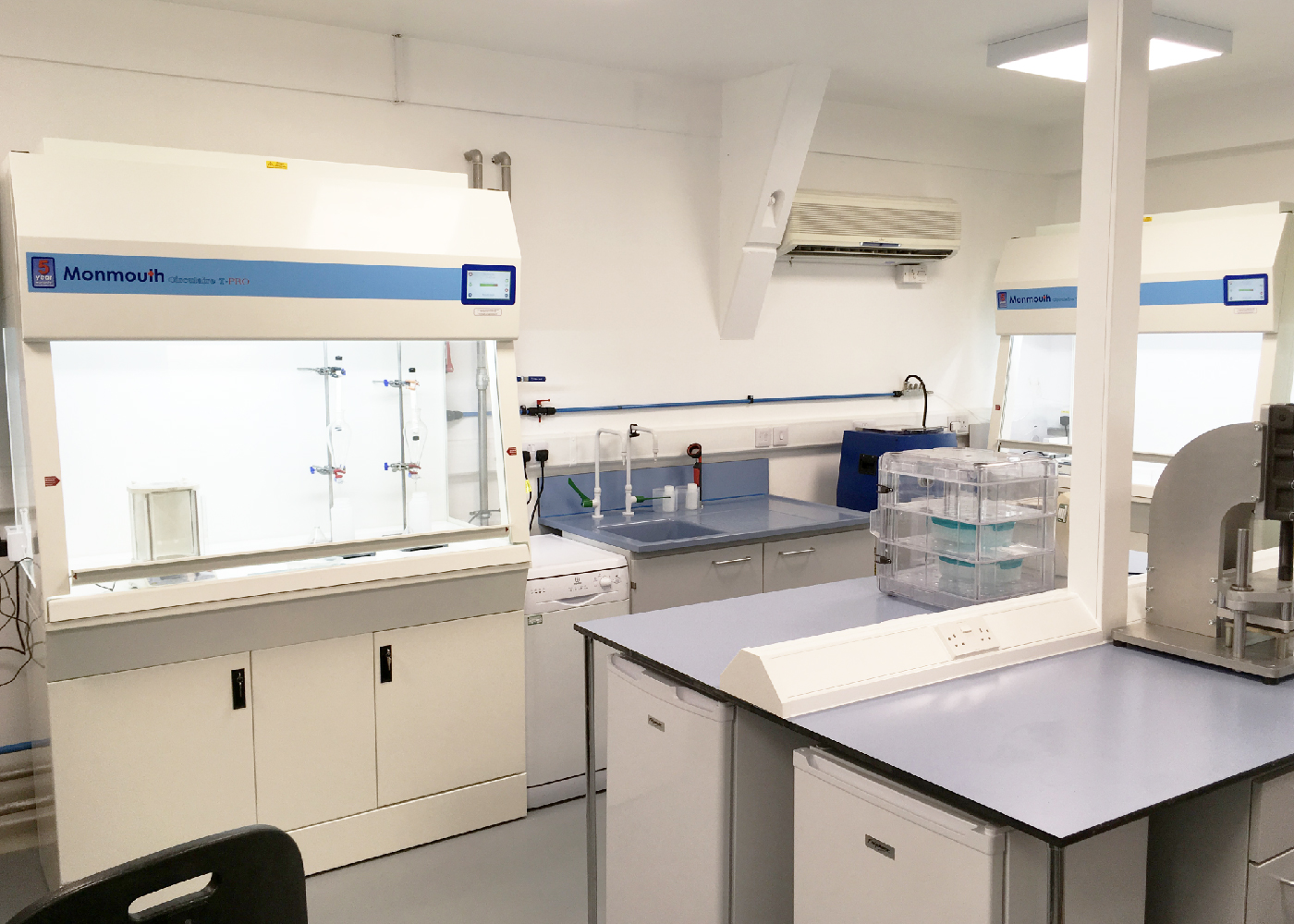
Comparing Non-Ducted and Ducted Fume Cupboards.
A Comprehensive Guide to Fume Cupboards
When it comes to maintaining a safe laboratory environment, selecting the correct fume cupboard is vital. Both ducted and recirculating fume cupboards offer distinct advantages and disadvantages, impacting factors such as cost, maintenance, and environmental sustainability.
Non-Ducted Fume Cupboards
Pros
- Lower Installation Costs: Non-ducted systems have a lower initial installation cost. The total CAPEX, including delivery, installation, and commissioning, is £6,506.00, which is substantially less than ducted systems.
- Energy Efficiency: These systems are more energy-efficient, with an annual electricity cost of approximately £100.00 at 0.5 m/s airflow.
- Flexibility and Mobility: Non-ducted fume cupboards can be easily moved and reinstalled, offering greater flexibility for laboratories that may undergo reconfiguration or relocation.
- Environmental Sustainability: Non-ducted systems are more environmentally friendly as they recirculate air within the laboratory after filtration, reducing the need for external ducting and associated energy losses. They also minimise the release of contaminants into the external environment.
Cons
- Higher Maintenance Costs: Over a five-year period, the operating and maintenance costs for non-ducted systems are higher. This includes the recommended annual replacement of activated carbon filters.
- Potential for Filter Saturation: Non-ducted systems rely on filters to remove hazardous substances. If not properly maintained, there is a risk of filter saturation, which can compromise the system’s efficiency and safety.
- Limited Suitability for High-Hazard Applications: Non-ducted systems may not be suitable for all types of hazardous materials, especially those that produce highly toxic or corrosive fumes.
Ducted Fume Cupboards
Pros
- Efficient Removal of Hazardous Gases: Ducted fume cupboards are highly effective at expelling hazardous gases and vapours outside the building, ensuring optimal air quality within the laboratory.
- Lower Maintenance Costs: With fewer components to service, ducted systems generally have lower maintenance requirements.
- Consistency in Performance: These systems provide consistent airflow and containment, which is essential for high-volume and high-hazard applications.
Cons
- High Initial Installation Costs: The installation of a ducted fume cupboard is significantly more expensive. The total capital expenditure (CAPEX) for a ducted system, including delivery, installation, and ducting (Fan, inverter + duct (2no. Straight + 2no. Bend)), reaches £11,251.00.
- Higher Energy Consumption: Ducted systems consume more electricity. For instance, at 0.5 m/s airflow, the electricity cost is in excess of £500.00, annually.
- Lack of Flexibility: Once installed, ducted systems are not easily relocated, limiting their flexibility within dynamic laboratory environments.
Your Key Buying Questions Answered
Which non-ducted fume cupboard offers the best filtration efficiency for chemical vapours?
Monmouth Scientific’s Recirculating (Non-Ducted) Fume Cupboards use advanced activated carbon and HEPA filter technology to achieve exceptional capture efficiency for a wide range of chemical vapours.
Each system is factory-tested and performance-validated to ensure compliance with international containment standards.
For specific solvent or chemical applications, our team can recommend the optimal filter configuration.
How do I choose between ducted and ductless fume cupboards for my lab?
Your choice depends on the nature of your work and the substances handled.
Ductless (recirculating) cupboards are ideal for laboratories seeking flexibility, mobility, and reduced energy costs, while ducted systems are often preferred for high-volume solvent use or continuous operations.
Our technical specialists can help you assess the most suitable configuration based on your chemical inventory, airflow requirements, and facility layout.
Are Monmouth Scientific’s recirculating fume cupboards compliant with EN 14175 or BS 7989?
Yes. All Monmouth Scientific Fume Cupboards are designed, manufactured and tested in accordance with EN 14175 and BS 7989, ensuring full compliance with UK and European safety standards.
Each system is supplied with a validation certificate confirming airflow performance and filtration integrity.
What maintenance schedule is required for carbon filters in a ductless fume cupboard?
Filter life varies depending on usage and chemical load, but typically, carbon filters require replacement every 12 months.
Monmouth Scientific provides full maintenance and filter replacement support, along with guidance on safe handling and disposal.
Regular airflow and sensor checks are also recommended to maintain peak performance.
Can Monmouth Scientific fume cupboards be customised for specific solvent applications?
Absolutely. Monmouth Scientific offers tailored solutions for specialised applications, including solvent-specific filter media, acid-resistant internal linings, and bespoke sizes to fit your workspace.
Our engineers can design systems around your exact process requirements, ensuring optimal safety and efficiency.
Do you offer a model suitable for small university teaching labs or mobile setups?
Yes. Our non-ducted range includes compact, mobile units designed for education, research, and small-scale laboratory environments.
With no fixed ducting and low running costs, these models provide flexibility to move between work areas or teaching spaces while maintaining full safety compliance.
How energy-efficient are Monmouth’s non-ducted fume cupboards compared to ducted models?
Non-ducted fume cupboards consume significantly less energy, as they recirculate clean air rather than exhausting it through external ducting.
This typically results in energy savings of up to 70%, lowering operational costs while maintaining excellent containment performance.
Cost Comparison
The initial capital expenditure (CAPEX) for a non-ducted system like the CT1100 is significantly lower compared to the ducted DFC1200. However, over five years, the operational expenditure (OPEX) for the non-ducted system is higher.
The overall cost over five years for the non-ducted system is still 28% less than the cost for the ducted system. This cost efficiency, combined with the environmental benefits, makes non-ducted systems an attractive option for many laboratories.
| Non-Ducted Fume Cupboard | Ducted Fume Cupboard | |||
| Equipment + Installation | CT1100
1100mm x 1285mm x 700mm (WDH) |
£5,911.00 | DFC1200
1200mm x 700mm x 1026mm (WDH) |
£3,801.00 |
| Delivery + Installation + Commissioning | £595.00 | Delivery + Installation + Ducting* | £7,450.00 | |
| CAP EX TOTAL | £6,506.00 | CAP EX TOTAL | £11,251.00 | |
| £4,745.00 | 73% | |||
| Operating + Maintenance | Electricity Use @ 0.5m/s** | £105.78 | Electricity Use @ 0.5m/s** | £509.18 |
| £403.40 | 79% | |||
| Service + Filters*** | £1,044.00 | Service | £370.00 | |
| (£674.00) | -65% | |||
| OP EX TOTAL**** | £5,748.90 | OP EX TOTAL**** | £4,395.90 | |
| Total | NON-DUCTED TOTAL | £12,254.90 | DUCTED TOTAL | £15,646.90 |
| TOTAL SAVING NON-DUCTED. vs DUCTED | £3,392.00 | 28% | ||
* Duct run cost based upon; Fan, inverter + duct (2no. Straight + 2no. Bend)
** Energy usage; 8 hrs/365 days @ 22.5p/kWh
*** MonSci recommendation to replace activated carbon filters annually (2no. Filters in CT1100)
****Operating + Maintenance over a 5-year period
Accurate July 2024
Environmental and Sustainable Benefits of Non-Ducted Systems
One of the most compelling advantages of non-ducted fume cupboards is their environmental sustainability. By recirculating filtered air back into the laboratory, these systems reduce the energy required for heating or cooling replacement air, which is particularly beneficial in large facilities. This reduction in energy consumption directly translates to lower greenhouse gas emissions, contributing to a more sustainable laboratory operation.
Furthermore, the reduced need for extensive ducting infrastructure not only cuts down on material usage but also minimises the environmental impact associated with production and installation. The flexibility and mobility of non-ducted systems also mean that laboratories can adapt to changing needs without the environmental cost of installing new ductwork.
Summary
Choosing between ducted and non-ducted fume cupboards depends on a variety of factors, including budget, specific laboratory requirements, and sustainability goals.
Ducted systems offer reliability and lower maintenance costs, making them ideal for high-hazard applications. In contrast, non-ducted systems provide significant installation cost savings, energy efficiency, and environmental benefits, making them a strong contender for many laboratories, especially those focused on sustainability.

